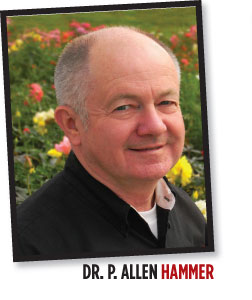9/15/2010
Growing Ideas: Shades of Gray
Dr. P. Allen Hammer

One thing I learned long ago, not everyone will agree with what I say or write.
The reason I approach this subject—all of us at times must realize there are things that are black and white, yet other times there’s a lot of gray in our world. And the problem most of us face is, when is a discussion or answer black and white, and when is a discussion or answer in that gray area?
For example, in solving greenhouse problems, the grower is often faced with conflicting cause-and-solution from different people. Plant growing recommendations can also vary greatly depending on the source of those recommendations. I sometimes get rather frustrated when someone argues about something I think is black and white, particularly if they can’t provide a convincing counter argument. But on the other hand, I’m more than willing, and always encourage, a lively discussion (some still consider it an argument) when those discussions add new data and facts to the issue being discussed.
Everyone must be willing to change their thinking when given new facts or an improved approach to doing something they’ve done one way numerous times in the past. Our rapidly changing world and advances in technology require a continuing reassessment of things we consider gray. But it also requires we change our black-and-white thinking when new facts emerge, disproving those firmly held beliefs. I’ve often told students things written in textbooks are subject to change as we add new knowledge through research and study. Written facts are based on the best available data at the time of writing.
So, whom does a grower believe and trust when seeking answers to questions, problem solving and production recommendations? First and most important, the information source should have a solid foundation of knowledge on the particular subject. Second, the information source should have direct experience with the specific problem or recommendation. And equally important, the information source should collect the appropriate data to make an informed decision. Too often I see an “off-the-cuff” answer accepted as a “black-and-white” solution to a serious greenhouse production problem.
It’s easy to walk into a greenhouse with an air of expertise and suggest a solution to a problem. It’s much more difficult to say “I don’t know” or “We need to collect additional data before I can suggest a solution.” Or say, “We need to check with the person with more expertise on the particular area of concern.”
Growers should always feel free to question even the experts. Ask questions until you completely understand an answer and feel comfortable that the answer is based on real data and experience.
Growers must also filter all the information they receive as to the appropriateness to their particular greenhouse and production methods. There are times, with a little thought and planning, when growers can implement a change in their production to solve a problem that will significantly improve the finished crop.
For example, using the same fertilizer and pH control for geranium and petunia production will in almost every case result in poor performance of either the geraniums or petunias. Redesigning a greenhouse watering system to allow a different fertility program for the petunias and geraniums is not only possible, but I think it’s essential. To me, the gray part of that recommendation is how to design the fertility system. And the “black-and-white” part is petunias need a lower pH than the geraniums. Yet, some will quickly and correctly argue that in some production situations the pH differences can be controlled by using a higher pH root medium with added lime at potting for the geraniums.
My point: Growers must seek the best information available and consider all solutions, but always remember the goal is a quality plant using the most appropriate and cost-affective approach to solving a problem in your particular greenhouse facility. Always remember, the destination (“wow” on the retail shelf) is much more important than the trip (how you obtain the “wow” on the retail shelf).
GT
Dr. P. Allen Hammer is a retired professor of floriculture at Purdue University, West Lafayette, Indiana, and is now in product development and support for Dümmen USA.